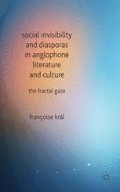Abstract
The issue of visibility presents itself in a most pressing way in the visual arts for various reasons. The body is a prerequisite for social visibility in the sense that its material existence is what makes me visible or at least what allows me to become perceptible to others — who may choose to acknowledge my presence or ignore it, as discussed in Chapter 2. The neo-phenomenological approach2 in relation to which I have positioned my discussion of invisibility in Chapter 2 implies that while my existence as a human being comes first and takes precedence over some pre-defined essence — or as JeanPaul Sartre put it ‘l’existence précède l’essence’ (existence precedes essence) (Sartre, 1996, 29)3 — this needs to be acknowledged by others, failing which my existence fails to materialize into a fully-fledged social existence. In other words, the fact that I come across as being materially present through my body is not enough for others around me to grasp the complexity of my existence as a human being, nor even that of my body whose materiality creates an illusionary sense of ‘thingness’.
It may seem less than entirely coincidental that at the very moment that the white, heterosexual male body ceased to hold the standard of the Universal Ideal, the very question of the body’s image was discarded by avant-garde art […] My purpose is not to denigrate modernism. But it is important that one particular form of representation, such as abstraction, should not continue to hold the mantle of being considered more ‘radical’ in both artistic and political terms than any other.
(Mizoeff, 1995, 8)1
Access this chapter
Tax calculation will be finalised at checkout
Purchases are for personal use only
Preview
Unable to display preview. Download preview PDF.
Notes
Nicholas Mirzoeff, Bodyscape. Art, Modernity and the Ideal Figure (New York: Routledge, 1995).
Sartre, Jean-Paul, L’Existentialisme est un Humanisme (Paris: Gallimard, 1996 [1946]).
Elizabeth Grosz, ‘Bodies-Cities’, in Beatriz Colomina (ed.), Sexuality and Space (New York: Princeton Architectural Press, 1992, 241–54, 243).
Jean-Luc Nancy, Corpus (Paris: Fayard, 1992).
Lisa Lowe. Critical Terrains: French and British Orientalisms. (Ithaca, NY/London: Cornell University Press, 1991).
Daniel Pick, Faces of Degeneration: A European Disorder, c.1848–1918 (Cambridge University Press, 1989).
In Time and the Other, Johannes Fabian argues that ‘the ability to visualize a culture or society almost becomes synonymous for understanding it’ (Fabian Johannes, Time and the Other: How Anthropology Makes its Object (New York: Columbia University Press, 1983, 106).
Stuart Hall, Representation: Cultural Representations and Signifying Practices (London: Thousand Oaks, 1997).
Robert Young J.C. Colonial Desire: Hybridity in Theory, Culture and Race (London: Routledge, 2002 (1995)).
Annie Coombes, E. Annie and Steve Edwards ‘Site unseen: Photography in the Colonial Empire: Image of subconscious eroticism’, Art History, 12, 4 (1989) 510–16.
Georges Didi-Huberman. Ouvrir Venus: Nudité, Rêve, Cruauté (Paris: Gallimard, 1999).
Mona Hatoum, Untitled (Wheelchair), 1998, Stainless Steel and rubber (97 X 50 X 84), reprinted in The Migrant’s Time: Rethinking Art History and Diaspora (Saloni Mathur (ed.) New York/London: Yale University Press, 2011, 13).
Gilles Deleuze, A Thousand Plateaus: Capitalism and Schizophrenia (Paris: Les Editions de Minuit, 1980).
Author information
Authors and Affiliations
Copyright information
© 2014 Françoise Král
About this chapter
Cite this chapter
Král, F. (2014). Visibility, Representation and Agency in the Visual Arts: the Body in Question. In: Social Invisibility and Diasporas in Anglophone Literature and Culture. Palgrave Macmillan, London. https://doi.org/10.1057/9781137401397_4
Download citation
DOI: https://doi.org/10.1057/9781137401397_4
Publisher Name: Palgrave Macmillan, London
Print ISBN: 978-1-349-48638-0
Online ISBN: 978-1-137-40139-7
eBook Packages: Palgrave Literature CollectionLiterature, Cultural and Media Studies (R0)

